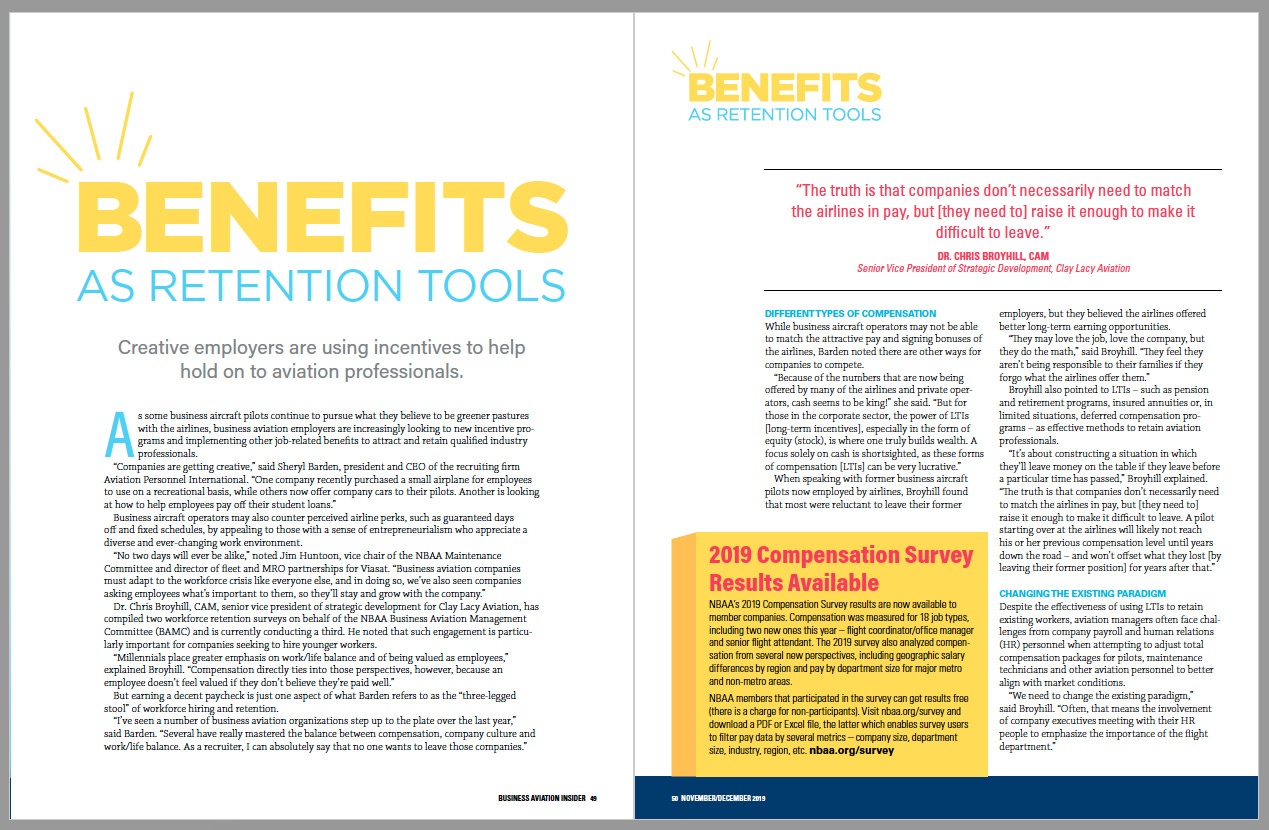Employers are using benefits and incentives as creative retention tools to hold on to business aviation professionals.
As some business aircraft pilots continue to pursue what they believe to be greener pastures with the airlines, business aviation employers are increasingly looking to new incentive programs and implementing other job-related benefits to attract and retain qualified industry professionals.
“Companies are getting creative,” said Sheryl Barden, president and CEO of the recruiting firm Aviation Personnel International. “One company recently purchased a small airplane for employees to use on a recreational basis, while others now offer company cars to their pilots. Another is looking at how to help employees pay off their student loans.”
Business aircraft operators may also counter perceived airline perks, such as guaranteed days off and fixed schedules, by appealing to those with a sense of entrepreneurialism who appreciate a diverse and ever-changing work environment.
“No two days will ever be alike,” noted Jim Huntoon, vice chair of the NBAA Maintenance Committee and director of fleet and MRO partnerships for Viasat. “Business aviation companies must adapt to the workforce crisis like everyone else, and in doing so, we’ve also seen companies asking employees what’s important to them, so they’ll stay and grow with the company.”
Dr. Chris Broyhill, CAM, senior vice president of strategic development for Clay Lacy Aviation, has compiled two workforce retention surveys on behalf of the NBAA Business Aviation Management Committee (BAMC) and is currently conducting a third. He noted that such engagement is particularly important for companies seeking to hire younger workers.
“Millennials place greater emphasis on work/life balance and of being valued as employees,” explained Broyhill. “Compensation directly ties into those perspectives, however, because an employee doesn’t feel valued if they don’t believe they’re paid well.”
But earning a decent paycheck is just one aspect of what Barden refers to as the “three-legged stool” of workforce hiring and retention tools.
“I’ve seen a number of business aviation organizations step up to the plate over the last year,” said Barden. “Several have really mastered the balance between compensation, company culture and work/life balance. As a recruiter, I can absolutely say that no one wants to leave those companies.”
DIFFERENT TYPES OF COMPENSATION
While business aircraft operators may not be able to match the attractive pay and signing bonuses of the airlines, Barden noted there are other ways for companies to compete. “Because of the numbers that are now being offered by many of the airlines and private operators, cash seems to be king!” she said.
“But for those in the corporate sector, the power of LTIs [long-term incentives], especially in the form of equity (stock), is where one truly builds wealth. A focus solely on cash is shortsighted, as these forms of compensation [LTIs] can be very lucrative.”
When speaking with former business aircraft pilots now employed by airlines, Broyhill found that most were reluctant to leave their former employers, but they believed the airlines offered better long-term earning opportunities.
“They may love the job, love the company, but they do the math,” said Broyhill. “They feel they aren’t being responsible to their families if they forgo what the airlines offer them.” Broyhill also pointed to LTIs – such as pension and retirement programs, insured annuities or, in limited situations, deferred compensation programs – as effective methods to retain aviation professionals.
“It’s about constructing a situation in which they’ll leave money on the table if they leave before a particular time has passed,” Broyhill explained. “The truth is that companies don’t necessarily need to match the airlines in pay, but [they need to] raise it enough to make it difficult to leave.
A pilot starting over at the airlines will likely not reach his or her previous compensation level until years down the road – and won’t offset what they lost [by leaving their former position] for years after that.”
CHANGING THE EXISTING PARADIGM
Despite the effectiveness of using LTIs to retain existing workers, aviation managers often face challenges from company payroll and human relations (HR) personnel when attempting to adjust total compensation packages for pilots, maintenance technicians and other aviation personnel to better align with market conditions.
“We need to change the existing paradigm,” said Broyhill. “Often, that means the involvement of company executives meeting with their HR people to emphasize the importance of the flight department.”
That also means pointing out to HR that the company can save money in the long run by retaining – instead of trying to replace – aviation personnel. Jo Damato, CAM, NBAA vice president for educational strategy and workforce development, pointed to the association’s engagement efforts to shift the perception of the value of business aviation professionals. Resources like NBAA’s Compensation Survey can help encourage companies to look at their complete employment packages for pilots, maintenance technicians and others.
“These [retention] concerns need to reach the C-suite,” declared Damato. Despite some promising developments, Broyhill believes too few companies have realized the importance of offering improved compensation and LTIs to retain their aviation employees.
“Many still don’t see the big picture and just don’t understand what must be replaced,” said Broyhill. “Even if they’re able to find a new person to fill that position, there’s still a loss of experience, productivity and morale.” “That’s a big issue that’s only going to get worse before it gets better,” he concluded. “I’ve had several pilots tell me, ‘I’m embarrassed by what I make here.’ When people talk in those terms, they aren’t speaking well of their company.” Review NBAA’s workforce initiatives at nbaa.org/workforce.
NOT JUST FOR PILOTS
While the shortage of pilots garners the most headlines, the ongoing aviation staffing crisis also affects companies seeking to hire and retain qualified aircraft maintenance technicians (AMTs).
“Like other industries, the main concern is on quality of life issues,” explained Jim Huntoon, vice chair of the NBAA Maintenance Committee and director of fleet and MRO partnerships for Viasat. “Maintenance technicians may not often leave our ranks to work for the airlines, but they will move to another company within the industry, particularly to move up the ladder. That means that more flight department managers are now asking themselves, ‘How do I keep them working for me?’”
As with pilots, HR often underestimates the importance of AMTs to the company. However, the challenge of convincing doubters of the value of maintenance technicians is even greater, Huntoon noted, as government pay tables still consider an AMT to be an unskilled profession.
“We have a shortage of technicians, and they’re every bit as valuable as pilots, but it doesn’t cost as much to train them,” noted Huntoon. An AMT job “must be recognized as a position that demands respect, compensation and opportunity.
NOTE
2019 Compensation Survey Results Available NBAA’s 2019 Compensation Survey results are now available to member companies. Compensation was measured for 18 job types, including two new ones this year – flight coordinator/office manager and senior flight attendant. The 2019 survey also analyzed compensation from several new perspectives, including geographic salary differences by region and pay by department size for major metro and non-metro areas. NBAA members that participated in the survey can get results free (there is a charge for non-participants).
Visit nbaa.org/survey and download a PDF or Excel file, the latter which enables survey users to filter pay data by several metrics – company size, department size, industry, region, etc.
This article was originally featured in the Nov/Dec 2019 issue of NBAA’s Business Aviation Insider magazine. Please visit NBAA.org or download a copy here.


